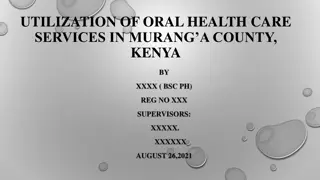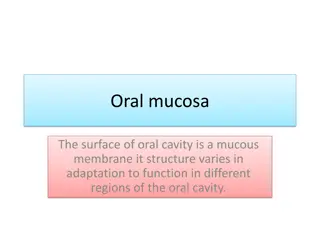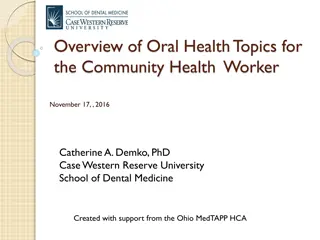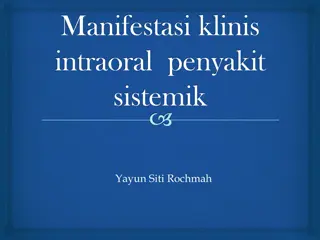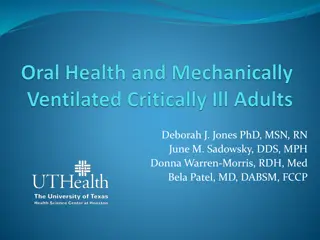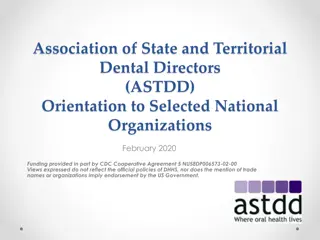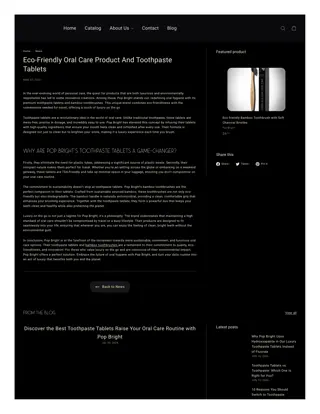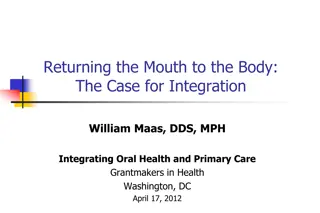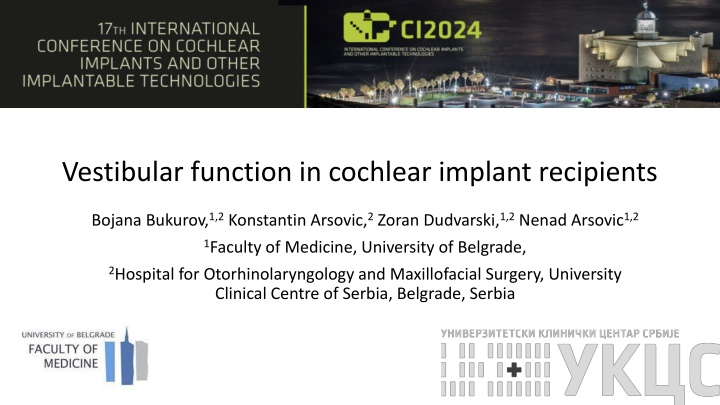
Vestibular Function in Cochlear Implant Recipients
Explore the intricate relationship between vestibular function and deafness in cochlear implant recipients, including historical perspectives, common vestibular disorders, and the impact of cochleovestibular anomalies. Learn about the consequences of impaired labyrinths on visual stability, disease progression, and quality of life.
Download Presentation

Please find below an Image/Link to download the presentation.
The content on the website is provided AS IS for your information and personal use only. It may not be sold, licensed, or shared on other websites without obtaining consent from the author. If you encounter any issues during the download, it is possible that the publisher has removed the file from their server.
You are allowed to download the files provided on this website for personal or commercial use, subject to the condition that they are used lawfully. All files are the property of their respective owners.
The content on the website is provided AS IS for your information and personal use only. It may not be sold, licensed, or shared on other websites without obtaining consent from the author.
E N D
Presentation Transcript
Vestibular function in cochlear implant recipients Bojana Bukurov,1,2Konstantin Arsovic,2Zoran Dudvarski,1,2Nenad Arsovic1,2 1Faculty of Medicine, University of Belgrade, 2Hospital for Otorhinolaryngology and Maxillofacial Surgery, University Clinical Centre of Serbia, Belgrade, Serbia
Those who dont know history are condemned to repeat it. W. James (1882) first description of vertigo in a deaf person R. Barany (1907) describes bilateral areflexia on caloric test in a deaf person Dandy (1941) describes oscillopsia and postural instability which aggravates with visual deprivation in patients who underwent bilateral resection of vestibular nerve Movement induced oscillopsia (1965) First precise definition of idiopathic bilateral vestibulopathy (BVP, 1989) Persons with bilateral absence of vestibular evoked myogenic potentials (VEMP) may have a normal caloric response (2009)
Vestibular function and deafness Sensorineural hearing loss (SNHL) is the most common sensory deficit, encountered in 3 of 1000 live births1 Prevalence of vestibular deficit in these patients is very high, between 20-70% Over 50% of children with severe SNHL have abnormalities of vestibular function, and 35% has severe loss2 Most of them will never experience vertigo 1 National Center for Hearing Assessment and Management (NCHAM). Epidemiology & Statistic Program, NIDCD, 11/2006. 2 Cushing SL, Gordon KA, Rutka JA, James AL, Papsin BC. Vestibular end-organ dysfunction in children with sensorineural hearing loss and cochlear implants: an expanded cohort and etiologic assessment. Otol Neurotol. 2013 Apr;34(3):422-8.
What if there is a concomitant cochlear and vestibular pathology? Usher, CHARGE, Waardenburg, BOR and Pendered syndrome Cochleovestibular anomalies: Incomplete partition (I-III) Isolated EVA Common cavity Congenital CMV higher incidence of complete absence of vestibular function than SNHL Meningitis Ototoxic medications
What happens when labyrinths do not function properly? Due to reduced VOR gain, visual surrounding cannot be stabilised, which leads to oscillopsias and decreased visual acuity Around 60% of patients have slow but progressive disease, and the rest have episodic instability which lead to bilateral loss of function Progressive course with repeated vertigo attacks has been described BVP lowers the quality of life in 90% of patients3 3 Zingler VC, Weintz E, Jahn K, Huppert D, Cnyrim C, Brandt T, Strupp M. Causative factors, epidemiology, and follow-up of bilateral vestibulopathy. Ann N Y Acad Sci. 2009 May;1164:505-8.
In the long run BPV leads to distorted space memory and hippocampal atrophy4 There is an association between BVP and impaired cerebellar function5,6 Cerebellar Ataxia, Neuropathy and Vestibular Areflexia Syndrome (CANVAS)7 4 Kremmyda O, H fner K, Flanagin VL, Hamilton DA, Linn J, Strupp M, Jahn K, Brandt T. Beyond Dizziness: Virtual Navigation, Spatial Anxiety and Hippocampal Volume in Bilateral Vestibulopathy. Front Hum Neurosci. 2016 Mar 31;10:139. 5 Reich SG, Boatman-Reich D. Causative factors and epidemiology of bilateral vestibulopathy in 255 patients. Ann Neurol. 2007 Nov;62(5):524-532. 6 Wagner JN, Glaser M, Brandt T, Strupp M. Downbeat nystagmus: aetiology and comorbidity in 117 patients. J Neurol Neurosurg Psychiatry. 2008 Jun;79(6):672-7. 7 Szmulewicz DJ, Waterston JA, Halmagyi GM, Mossman S, Chancellor AM, McLean CA, Storey E. Sensory neuropathy as part of the cerebellar ataxia neuropathy vestibular areflexia syndrome. Neurology. 2011 May 31;76(22):1903-10.
Diagnostic criteria for BVP8 A. Chronic vestibular syndrome with: 1) Unsteadiness while walking or standing plus at least one under 2) and 3). 2) Movement-induced blurred vision or oscillopsia during walking or quick head/body movements 3) Worsening of symptoms in darkness or on uneven ground No symptoms at rest Bilaterally reduced or absent vestibulo-ocular reflex (VOR) 1) Bilaterally pathological horizontal angular VOR gain <0.6, measured by the video-HIT or scleral-coil technique and/or 2) Reduced caloric response (sum of bithermal max. peak SPV on each side <6 /sec) and/or 3) Reduced horizontal angular VOR gain <0.1 upon sinusoidal stimulation on a rotatory chair (0.1 Hz, Vmax = 50 /sec) and a phase lead >68 degrees (time constant <5 sec) Not better accounted for by another disease B. C. D. 8 Strupp M, Kim JS, Murofushi T, Straumann D, Jen JC, Rosengren SM, Della Santina CC, Kingma H. Bilateral vestibulopathy: Diagnostic criteria Consensus document of the Classification Committee of the B r ny Society. J Vestib Res. 2017;27(4):177-189.
Effects of CI Potential mechanisms of damage: 1. Induction of serous labyrinthitis due to opening of membranous labyrinth 2. Ingress of blood in the inner ear 3. Mechanical injury during electrode insertion (rupture of basilar membrane, fracture of bony lamina, transection of cochlear ductus and fracture of modiolus) 4. Working with high-speed burrs 5. Transmission of electrical current (electrophysiologic changes) Candidates with intact vestibular function are at higher risk of development of unsteadiness after implantation
Histopathological findings in temporal bones with CI There is strong correlation of vestibular damage if bony lamina or basilar membrane are destroyed In over 50% of bones compete fibrosis of vestibular system was found Distortion or collapse of saccular membrane Osteoneogenesis Reactive neurinomas9 Unilateral cochlear hydrops is evident in 59% of cases10 (blockage of flow between sacculus and cochlea) 9 Tien HC. Linthicum FH Jr. Histopathologic changes in the vestibule after cochlear implantation. Otolaryngol Head Neck Surg 2002;127(04):260-264. 10 Handzel O, Burgess BJ, Nadol JB Jr. Histopathology of the peripheral vestibular system after cochlear implantation in the human. Otol Neurotol. 2006 Jan;27(1):57-64.
Our methodology From 2020, every person with severe SNHL who was a candidate for CI at our hospital, underwent complete vestibular testing (standard examination, VEMP with air-conducted TB 500 Hz, vHIT for all 6 canals, bithermal caloric testing with video-oculography) Up to now, 83 persons were implanted at our Clinic, of whom 41 children and 42 adults Fifty-two (52) patients had data available on vestibular testing: Forty (40) adults and 12 children Complete data for VEMP were available from 52, for vHIT from 46, and for caloric from 49 patients
Our short term results Associated vestibular damage was found to be as follows: Absent cVEMP unilaterally in 9 patients (17.3%) and bilaterally in 16 (30.8%) overall 48.1% Absent oVEMP unilaterally in 9 patients (17.3%) and bilaterally in 17 (32.7%) overall 50% VOR gain lowered <0.6 on vHIT in 5 patients unilaterally (10.9%) and 11 bilaterally (23.9%) overall 32.7% Hyporeflexia on caloric testing in 13 patients on one side (26.5%) and areflexia in 6 on both sides (12.2%) overall 38.7% Overall, 30 patients (57.7%) had some degree of peripheral dysfunction on these measurements, and 7 had BVP (13.5%)
PATIENTS (AGE) TIME WITH CI vHIT cVEMP CALORIC TEST STANDARD EXAMINATION (AIR TB 500 Hz) S. N. (16) 9 years Normal gain in all 6 canals Raised threshold, lower amplitude (0.45) Hyporeflexia on implanted side Normal E. K. (17) 5 years Normal gain in all 6 canals Absent (100 dB) Symmetrical Normal A. N. (11) 9 years Lower gains on implanted side for horizontal canal (0.77) Raised threshold, lower amplitude (0.52) Hyporeflexia on implanted side Normal P. S. (18) 16 years Normal gain in all 6 canals Absent (100 dB) Hyporeflexia on implanted side Normal O. T. (11) 6 years Lower gains on implanted side (0.52; RA /; RP 0.45) Absent Hyporeflexia on implanted side Normal I. T. (17) 6 years Normal gain in all 6 canals Raised threshold, lower amplitude (0.46) Symmetrical Normal
Why is this important? Risk of falls is higher = implant failure Patient with areflexia on caloric testing have 7.6 x higher risk for CI malfunction BVP leads to loss of space orientation (beware under water, or in darkness!) BVP also leads to other deficits in cognition, learning, memory and executive functions (hippocampal atrophy)
Can we help? Huge efforts of researchers worldwide, both on animal models, and now on humans, to develop and perfect vestibular implant (VI) Unexpected possibilities of adaptation on artificial vestibular input are discovered in humans: VOR restoration, improvement of visual capabilities while walking12 Vestibular rehabilitation 12 Guyot JP, Perez Fornos A. Milestones in the development of a vestibular implant. Curr Opin Neurol. 2019 Feb;32(1):145-153.
Conclusions BVP is most common accompanying sensory deficit in children with SNHL Usually develops based on the aetiology of damage, but it can be adverse, due to CI Recognition of vestibular damage in children who are candidates for CI is very important, since it has direct effect on their motor and cognitive development, balance maintenance, safety and their latter burden during everyday activities



